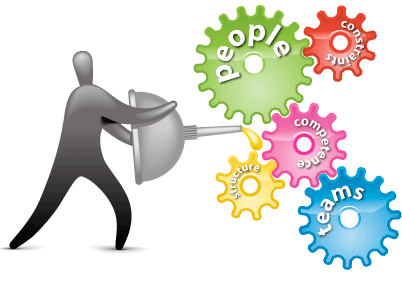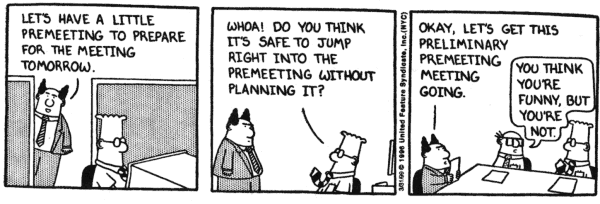 Somewhere along the line “meetings” has become a dirty word
Somewhere along the line “meetings” has become a dirty word
Filled calendars, bookings 3 deep, have become the norm in many of our lives that work feels like something we try to “squeeze in between meetings.”
At the morning team sync oft’ is heard… “Yesterday I was in meetings all day, I didn’t get anything done. Today is likely to be the same.“
Should voices rise up and say “eliminate meetings entirely…they are toxic!”?
Maybe we should have a meeting to discuss things? (Just kidding.)
Good Patterns
Consider a Meeting Alternative: Asynchronous Communication
Before you schedule that next meeting, think: Is there another way?
Chat, email, wiki, blog, RFC: The advantage of these async communication methods over a scheduled interruption, whoops, meeting – is that the conversation can easily be “quarantined.”
Someone who doesn’t mind being interrupted can monitor these message channels and respond – if they choose – in near real-time. Someone who is in the zone can turn off notifications and respond at their leisure.
Real-Time Collaboration and Discussion
Some things really are accomplished best via synchronous communication: retrospectives / post-mortems, 1-1 chats, sprint planning, kick-offs, backlog refinement, sprint reviews…
They help people communicate with each other quickly, to get to a point of common understanding efficiently – more so than 20 emails or DMs back and forth.
There is less potential for misunderstanding (provided folks say what they mean and mean what they say). Good meetings provide the opportunity for meaningful conflict as well as meaningful resolution.
Good meetings help make sure teams don’t just “Get Stuff Done” but get the right stuff done at the right time…
Things that help make good meetings good include:
- Having a clearly defined agenda/purpose
- Inviting as few people as possible
- Ensuring that meetings end as quickly as possible (set a time box…)
- Making sure attendees have sufficient time to prepare – (plan ahead…)
- Seeing that all invitees participated fully
- Making sure follow-up actions were clear and assigned
Bad Patterns
What Kind of Meeting is This?
Be clear on the purpose of the meeting, and communicate that at the outset.
Kim Scott in Radical Candor provides a nice framework for putting things on a calendar:
- 1:1 Conversations – Employees set the agenda, and managers listen and help them clarify
- Staff Meetings – Used to review metrics, provide “study hall” updates, and identify (but not make) key decisions
- Think Time – Used to block out time to be strategic, and to plan. David Marquets call this “Blue Work“
- “Big Debate” Meetings – Lower the tension by making it clear that you are debating, not deciding.
- “Big Decision” Meetings – Push decisions into the facts, pull facts into the decisions, and keep egos at bay
- All-Hands Meetings – Bring others along
- Meeting-Free Zones – Blocked-out time to not have meetings
Somethings to Ponder…
- What percentage of your total working time is spent in meetings (good, bad, indifferent)?
- What if you eliminated meaningless and/or unproductive meetings and replaced them with space to think, and work on the most important thing?

